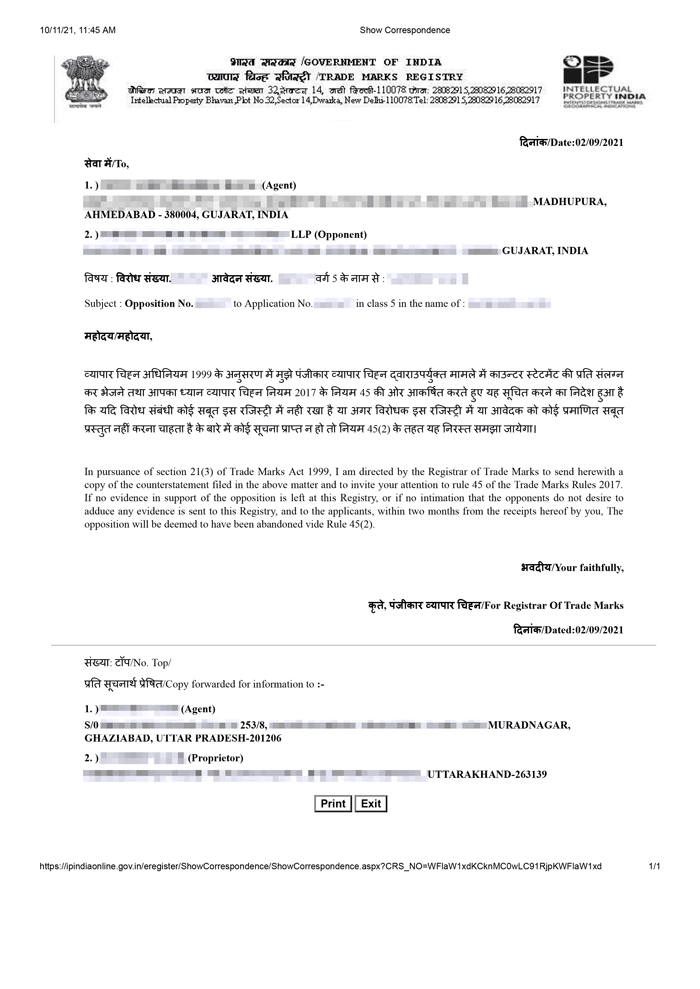Updated on November 01, 2025 05:33:18 PM
A Trademark is basically a mark or symbol that represents graphically. It can be a word, a design, a combination of words and colours or a logo. A trademark aids to distinguish a particular brand and build a distinct image in the marketplace. A Registered Trademarkcreates a unique impact in consumers’ minds regarding the goods and services that they serve.
The Trademark Registration is a long and complex procedure. The trademark opposition Process is one of the stages in the TM Registration. Trademark Opposition can be raised by anyone who feels infringement regarding their trademark. In this article, we will explore the complete stages of the process, the ground of opposition, the purpose, and the duration of the TM opposition process.

Section 9(1), Section 11 and Section 21 of the Trademark Act 1999 permit for objection or opposition to the applied Trademark. In these two situations, the applied trademark can be stuck in the middle of the registration process. Objections are raised by the registrar or examiner when they see any similarities to the existing registered Trademark.
Trademark Opposition is raised by the Third party. When the Trademark is advertised in the journal. It is published for all, if any person or third party has any issue regarding the trademark they can raise opposition, within four months from the date of publication. Its main purpose is to avoid infringement or dissolving of anyone's intellectual property rights.
There are numerous reasons why trademark opposition raises. Some of the grounds for Trademark opposition are given below:
The trademark opposition process includes many steps that are given below:
When the trademark has been published in the journal that is open for the opposition. If anyone finds some issue so they can raise opposition against the applied trademark
Here the opponent or third party has to fill Trademark opposition that is basically called “TM-O”. The opponent has to clear the ground of opposition and with this TMO the opponent has to attach all the supportive documents.
When the opponent files the notice of opposition, the applicant will get a notification regarding the opposed Trademark Registration. The applicant gets a copy of the opposition statement and other related documents from the opponent side.
It depends on the applicant that they want to proceed with the procedure otherwise they can refuse or abandon that applied trademark.
Within 2 months the applicant has to submit the counter statement in reply to the opposition. In this statement, they have to submit all the related documents in favour of their statements. The opponent also provides a copy of every piece of evidence to the applicant.
The applicant can also submit their relatable documents to the registrar as well as the opponent also. After that, the opponent will provide further documents to make their strong side.
After receiving the evidence from both sides (opponent and applicant) the registrar will conduct the hearing. In this Hearing, the registrar will give the equal opportunity to both parties to prove their sides. If the applicant will not present at the day hearing so the applied trademark will be abandoned and rejected.
After examining all the related evidence of the applicant and the opposition, the registrar decided whether the applied mark was registered or not. If the registrar is satisfied with the statements submitted by the applicant, the trademark will be accepted and registered. Otherwise, the applied trademark will be rejected or abandoned.
There are several purposes of trademark opposition some of these are given below:
Trademark Opposition Process can be a stuck point for your registration process. It can increase the chance of refusal or rejection. There are some points mentioned below that help to avoid the chance of a Trademark opposition process:
Trademark Registration is a long process and higher chance of trademark opposition. Here, “Litem Legalis” will help you to get your TM registration in an easier and hassle-free way. “Litem Legalis” will be your best choice because of:

Legal Consultation

Expert Lawyers

Lowest Fees

Quick Process
The trademark opposition process is also a main part of the Trademark Registration process. The TM opposition process also has many stages that include the filing of the TM-O, counter statements, reply and hearing. TM Opposition process helps to protect existing trademark rights. This process gives complete rights to an individual or business to raise their opposition and protect their brand identity.
However, the applicant has to submit all the related documents during the TM Registration. In case the applicant is stuck with the TM Opposition process so they have to submit all related and favourable statements to the registrar. To avoid these processes the applicant can take help from a professional TM attorney as well.
The cost of the trademark opposition filing is ₹2700 for e-filing.and ₹3000 for physical filing.
The trademark opposition process has many purposes such as preventing the solo rights of existing trademarks, preventing confusion, promoting fair competition, protecting consumer’s interests and also enhancing transparency.
When the registrar publishes the trademark in the journal, the opponent has to file an opposition within four months of the advertisement.
The Trademark opposition process includes many steps such as filing the notice of opposition, counter-statements, evidence in support of the opposition, hearing process and registration or rejection.
Disclaimer: The content provided on this site is intended for informational purposes only. Accessing or utilizing this site and its materials does not establish an attorney-client relationship. The information contained herein does not constitute legal or professional advice and should not be relied upon as such. It is not a substitute for obtaining legal counsel from a qualified attorney licensed in your jurisdiction